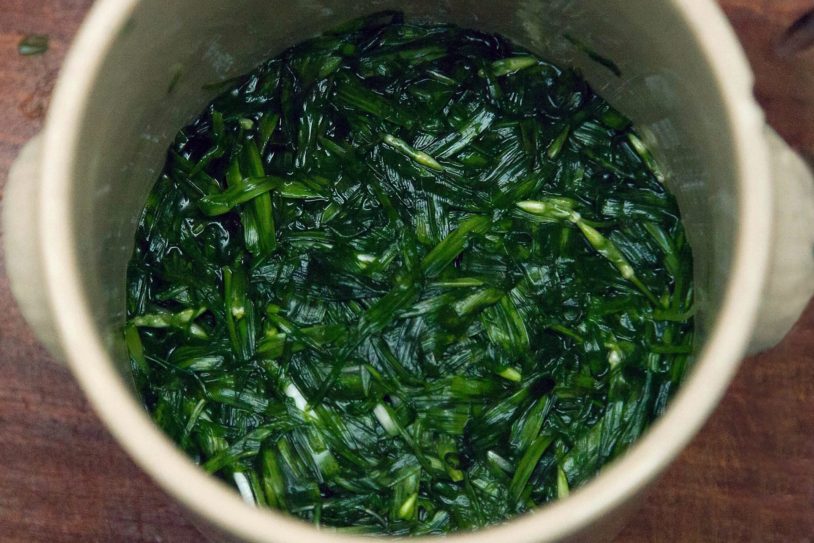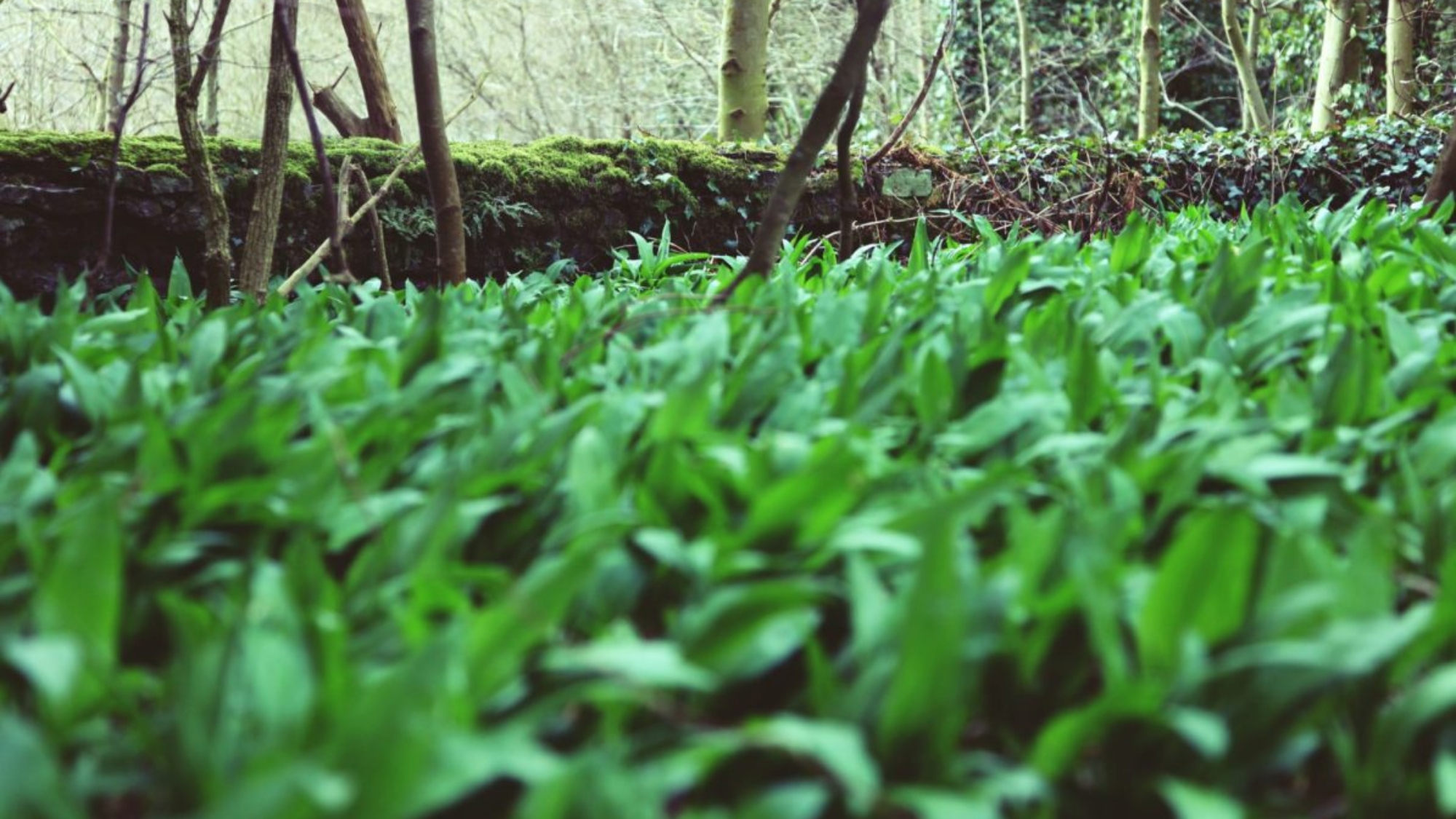The time for wild garlic (Allium ursinum) or ramsons and other wild alliums is almost upon us. Usually around February/March it starts to grow in shaded broadleaf woodlands on a nutrient rich Scottish soil. Garlicky smell that makes many salivate is a telltale sign that we’re in a right place at a right time.
Wild garlic tastes best when eaten raw, mouthfuls straight from the forest bed, in salads, sandwiches and pesto but also in soups, stir fries and more. Season for wild garlic doesn’t last very long and fresh leaves won’t store well. My favourite way of keeping some for later is through preserving by lacto-fermentation. Fermented wild garlic can be either eaten raw (my favourite), in soups and stews but also can be dried to produce powerful source of umami.
Meaning
There are at least two hypotheses about the meaning of a Latin name: A. usrinum (bears allium). I’m leaning towards the theory that tells that brown bears (Ursus arctos) after long winter sleep were waking just when garlic was in its best and they gorged on it. Alternatively the name could be derived from the constellation Ursa Major as to ancient Greeks ramsons were most northerly allium species.
Harvesting
Harvest your leaves, don’t bother about the bulbs, they are not worth the effort but also it’s illegal to uproot any plant in Scotland without the landowners permission.
Be aware that due to recent increase in popularity in foraging for ramsons and competition from non native few flowered leek and three cornered leek there is potential for putting local A.ursinum populations at risk. It takes 4 to 8 years for plant to develop from a bulbil to a fully grown specimen.
Whenever possible eat invasive leeks instead (equally as good in many dishes such as pesto, stir fries, some ferments and salads) and don’t over harvest native wild garlic. Keep an eye on known patches, harvest in rotation from various places and be sensible but most of all, enjoy.

Fermentation process
Lacto-fermentation is an ancient food preservation technique used by many different cultures as well as it’s highly satisfying if done properly. Unique flavour, crunch and unmistakable tang will add freshness to a dull winter diet. Dull diet is obviously based on assumption that we’re eating locally sourced food, rather than imported produce.
Process of lacto-fermentation happens when lactic acid bacteria (LAB) are decomposing sugars and other hydrocarbons to produce lactic acid and other organic compounds. This process happens best in an anoxic environment. Lactic acid is the main preservative that keeps unwanted bacteria and fungi at bay as well as it gives typical acidic flavour.
Taste
Metabolites of fermentation process not only restrain growth of pathogenic microorganisms but also help to maintain our physical and mental wellbeing. It is not difficult to find scientific publications discussing the importance of maintaining healthy gut flora as well as benefits of consuming fermented foods.
There is more to fermentation than strange smells and interesting flavours. It’s an evolutionary arms race in a micro scale. Try to imagine fermentation crock as a miniature rainforest or a vegetable patch, where plants are fighting for space and resources but instead of plants we have bacteria and fungi. These tiny organisms play different roles, excrete various metabolites to fight off competition. They tolerate different levels of pH and salinity.
For a good tasting ferment all these microorganisms are important. Our job is just to create favourable conditions for LAB, then step back, watch and control. You could compare it to gardening. Shredding and salting could be digging and sowing, massaging and compressing: raking and watering, temperature and oxygen control: weeding and fertilizing.

Recipe- Fermented wild garlic
To create a good ferment you’ll need:
- Fresh and clean Allium leaves
- Salt
- Fermentation vessel
Cut clean plants into pieces of about 3-6cm. That’s only due to practical reasons. It’s easier to take out smaller pieces from the jar.
Sprinkle approximately 1.5% to 2% of salt (15g-20g salt per 1kg of leaves). LAB are salt tolerant unlike most unwanted pathogenic microorganisms. Obviously if you add to much salt you’ll inhibit growth of LAB as well as your product will be very salty. If you think you’ve added too much just add more garlic leaves or other different plant such as garlic mustard or thinly sliced veg such as white cabbage
Pack tightly in ceramic or glass container and weight down. Ceramic weights or washed pebbles are good. Avoid metals as low pH they can react with acid as well as plastics as some can leach harmful chemicals. Remember to squeeze out as much air as possible and keep all plant matter submerged. Any sticking out pieces can be easily contaminated with moulds.
Keep your vessel out of direct sunlight and try to keep the temperature constant. Fermenting at lower temperatures (up to 16oC) for longer period of time will give you more control over the process as well as you’ll have greater chance of getting good quality product. I found that ferments done this way will store well for long period of times (over 2 years in the fridge without detrimental effect on texture or flavour).
When ready, transfer to smaller glass jars, pack tightly and keep in the refrigerator. When is it ready? Anywhere 5-20 days, depending on various factors such as temperature, salt used, amount of salt and many more. Trust your senses but when in doubt refer to literature.
The art of Fermentation by Sandor Felix Katz is one of my favourite books and I highly recommend it to anyone willing to dive into the ocean of lactic acid.
References
Sobolewska, D., Podolak, I. and Makowska-Wąs, J. (2013). Allium ursinum: botanical, phytochemical and pharmacological overview. Phytochemistry Reviews, 14(1), pp.81-97.
Oborny, B., Botta-Dukát, Z., Rudolf, K. and Morschhauser, T. (2011). Population ecology of Allium ursinum, a space-monopolizing clonal plant. Acta Botanica Hungarica, 53(3-4), pp.371-388.
Swain, M., Anandharaj, M., Ray, R. and Parveen Rani, R. (2014). Fermented Fruits and Vegetables of Asia: A Potential Source of Probiotics. Biotechnology Research International, 2014, pp.1-19.
Kim, B., Hong, V., Yang, J., Hyun, H., Im, J., Hwang, J., Yoon, S. and Kim, J. (2016). A Review of Fermented Foods with Beneficial Effects on Brain and Cognitive Function. Preventive Nutrition and Food Science, 21(4), pp.297-309.
V., Pöhö, P., Mattila, I., Lähdesmäki, H., Franzosa, E., Vaarala, O., de Goffau, M., Harmsen, H., Ilonen, J., Virtanen, S., Clish, C., Orešič, M., Huttenhower, C., Knip, M. and Xavier, R. (2015). The Dynamics of the Human Infant Gut Microbiome in Development and in Progression toward Type 1 Diabetes. Cell Host & Microbe, 17(2), pp.260-273.
Clapp, M., Aurora, N., Herrera, L., Bhatia, M., Wilen, E. and Wakefield, S. (2017). Gut microbiota’s effect on mental health: the gut-brain axis. Clinics and Practice, 7(4).
Azad, M., Sarker, M., Li, T. and Yin, J. (2018). Probiotic Species in the Modulation of Gut Microbiota: An Overview. BioMed Research International, 2018, pp.1-8.
Pisol, B., Abdullah, N., Khalil, K. A. and Nuraida, L (2015). Isolation and identification of lactic acid bacteria from different stages of traditional Malaysian tempeh production. Malaysian Journal of Microbiology.
